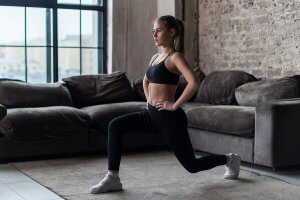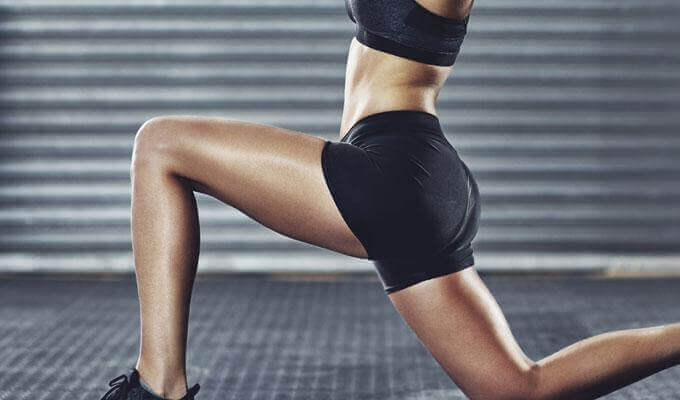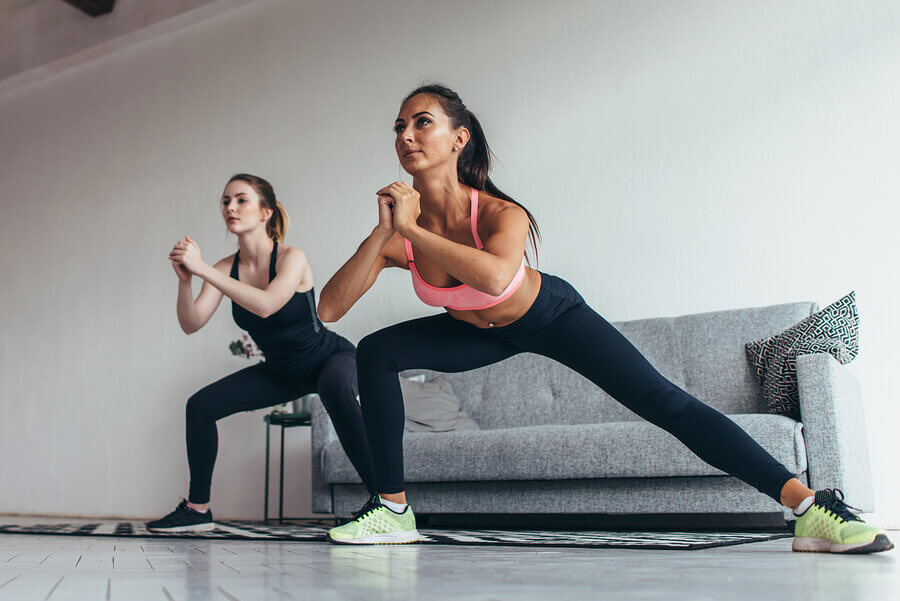Lunges: Routines to Work Out your Glutes and Legs

Lunges are hands down one of the best exercises for working out glutes and legs. In our article today, we want to show you a lunge routine to work them out. Check it out and get started!
Lunges are a great option to add to a lower body workout that focuses on one leg at a time. As if they weren’t enough as they are, you can do each variation holding dumbbells or holding a weight bar on your back or in front. How far you take your lunge will determine which muscles get the best workout.
Lunges are one of the best bodyweight leg exercises because they work out each muscle, from the glutes to the calves. Don’t forget to land softly, rise quickly, stay in balance and keep your upper body straight and upright.
The best way to work out your glutes and legs
Lunges are, as we mentioned above, one of the best ways to sculpt glutes and legs. But, the problem with lunges is that there’s almost always something wrong with the execution. If you don’t do lunges correctly, they lose a big part of their workout.
Unlike as most people do, try nailing the technique before diving into a workout. And remember that you’re going to use a lot of muscles to lunge, so the next day, you’ll feel the results.
Lunges: routines for glutes and legs
There are many different variations of lunges– getting sick of them would be nearly impossible. Here are some of the most popular variations:
1. Front lunge
Our first lunge is the classic exercise. To get started, stand up and put your feet together while pushing your shoulders back.
Next, lift your right leg and take a large step forward. Lower your body until your knee forms a 90-degree angle. After, return to the original position by pushing off your right heel.

2. Front lunge with weights
If you want to up the challenge, you can also do the exercise while holding a dumbbell in each hand, a bar on your shoulders or a weight above your head. However, make sure that you’ve mastered the front lunge technique first and can handle the weights.

3. Side lunges
In this exercise, you’ll bend your legs and step to your sides. Side lunges especially work out the abductor muscle group, including the glutes.
Aside from strengthening glutes and legs, this variation also improves flexibility. It’s easy to do: start by standing with your feet a hip-width apart and take a big step to the right.
Then, bend your right knee and push your hips backward, keeping your left leg straight and your two feet firmly planted on the floor. Push off back to the standing position and repeat on the left side.

The best lunge tips
Here are some tips to keep in mind when you do lunges:
- Make sure that you take big steps. Also, ensure that the knee of the opposite leg touches the floor when you lunge.
- Never let your knee go past your toes. Taking a big step will help prevent this.
- Try to lean forward instead of keeping your back completely straight.
- Stretching before and after every lunge is important.
- Remember to keep breathing throughout the entire exercise. Exhale as you push back to the original position.
- When you’re ready for a challenge, add some external resistance such as weights, kettlebells or medicine balls.
Before we wrap up, remember that lunges are a complete and essential bodyweight exercise that works for optimal glutes and legs as long as you do them correctly. Now that you know everything you need to know, why not add them into your workout plan?
Lunges are hands down one of the best exercises for working out glutes and legs. In our article today, we want to show you a lunge routine to work them out. Check it out and get started!
Lunges are a great option to add to a lower body workout that focuses on one leg at a time. As if they weren’t enough as they are, you can do each variation holding dumbbells or holding a weight bar on your back or in front. How far you take your lunge will determine which muscles get the best workout.
Lunges are one of the best bodyweight leg exercises because they work out each muscle, from the glutes to the calves. Don’t forget to land softly, rise quickly, stay in balance and keep your upper body straight and upright.
The best way to work out your glutes and legs
Lunges are, as we mentioned above, one of the best ways to sculpt glutes and legs. But, the problem with lunges is that there’s almost always something wrong with the execution. If you don’t do lunges correctly, they lose a big part of their workout.
Unlike as most people do, try nailing the technique before diving into a workout. And remember that you’re going to use a lot of muscles to lunge, so the next day, you’ll feel the results.
Lunges: routines for glutes and legs
There are many different variations of lunges– getting sick of them would be nearly impossible. Here are some of the most popular variations:
1. Front lunge
Our first lunge is the classic exercise. To get started, stand up and put your feet together while pushing your shoulders back.
Next, lift your right leg and take a large step forward. Lower your body until your knee forms a 90-degree angle. After, return to the original position by pushing off your right heel.

2. Front lunge with weights
If you want to up the challenge, you can also do the exercise while holding a dumbbell in each hand, a bar on your shoulders or a weight above your head. However, make sure that you’ve mastered the front lunge technique first and can handle the weights.

3. Side lunges
In this exercise, you’ll bend your legs and step to your sides. Side lunges especially work out the abductor muscle group, including the glutes.
Aside from strengthening glutes and legs, this variation also improves flexibility. It’s easy to do: start by standing with your feet a hip-width apart and take a big step to the right.
Then, bend your right knee and push your hips backward, keeping your left leg straight and your two feet firmly planted on the floor. Push off back to the standing position and repeat on the left side.

The best lunge tips
Here are some tips to keep in mind when you do lunges:
- Make sure that you take big steps. Also, ensure that the knee of the opposite leg touches the floor when you lunge.
- Never let your knee go past your toes. Taking a big step will help prevent this.
- Try to lean forward instead of keeping your back completely straight.
- Stretching before and after every lunge is important.
- Remember to keep breathing throughout the entire exercise. Exhale as you push back to the original position.
- When you’re ready for a challenge, add some external resistance such as weights, kettlebells or medicine balls.
Before we wrap up, remember that lunges are a complete and essential bodyweight exercise that works for optimal glutes and legs as long as you do them correctly. Now that you know everything you need to know, why not add them into your workout plan?
All cited sources were thoroughly reviewed by our team to ensure their quality, reliability, currency, and validity. The bibliography of this article was considered reliable and of academic or scientific accuracy.
- Barnes, D. (2009). Bodyweight Strength training strategies for gymnasts. Technique, (January), 16–18. https://doi.org/10.1016/j.neuron.2005.02.014
- Aguilera-Castells, Joan & Buscà, Bernat & Fort-Vanmeerhaeghe, Azahara & Solana-Tramunt, Mònica & Morales, Jose. (2017). Forces and positions in suspension lunge exercise.
This text is provided for informational purposes only and does not replace consultation with a professional. If in doubt, consult your specialist.








